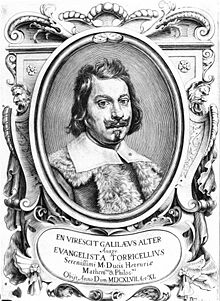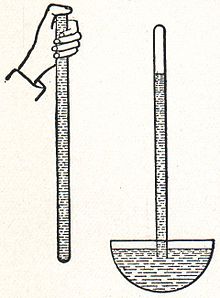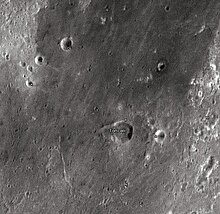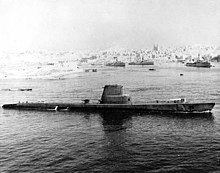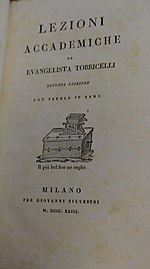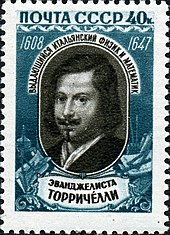Torricelli's work in physics
The perusal of Galileo's Two New Sciences (1638) inspired Torricelli with many developments of the mechanical principles there set forth, which he embodied in a treatise De motu (printed amongst his Opera geometrica, 1644). Its communication by Castelli to Galileo in 1641, with a proposal that Torricelli should reside with him, led to Torricelli traveling to Florence, where he met Galileo, and acted as his amanuensis during the three remaining months of his life.
Suction pumps and the invention of the barometer
Torricelli's work led to first speculations about atmospheric pressure, and to the corollary invention of the mercury barometer (from the Greek word baros, meaning weight ) -- the principle of which was described as early as 1631 by René Descartes, although there is no evidence that Descartes ever built such an instrument.
The barometer arose from the need to solve a theoretical and practical problem: a suction pump could only raise water up to a height of 10 metres (34 ft) (as recounted in Galileo's Two New Sciences). In the early 1600s, Torricelli's teacher, Galileo, argued that suction pumps were able to draw water from a well because of the "force of vacuum." This argument, however, failed to explain the fact that suction pumps could only raise water to a height of 10 metres.
After Galileo's death, Torricelli proposed, rather, that we live in a "sea of air" that exerts a pressure analogous in many ways to the pressure of water on submerged objects. According to this hypothesis, at sea level, the air in the atmosphere has weight that roughly equals the weight of a 10-meter column of water. When a suction pump creates a vacuum inside a tube, the atmosphere no longer pushes on the water column below the piston but still pushes down on the surface of the water outside, thus causing the water to rise until its weight counterbalances the weight of the atmosphere. This hypothesis might have led him to a striking prediction: That a suction pump might only raise mercury, which is 13 times heavier than water, to 1/13 the height of the water column (76 centimeters) in a similar pump. (It is possible however that Torricelli carried out the mercury experiment first, and then formulated his sea of air hypothesis ).
In 1643, Torricelli filled a meter-long tube (with one end sealed off) with mercury—thirteen times denser than water—and set the open end of the tube into a basin of the liquid metal and raised the sealed end so the tube stood vertically. The mercury level in the tube fell until it was about 76 centimetres (30 in) above the surface of the mercury basin, producing a Torricellian vacuum above. This was also the first recorded incident of creating permanent vacuum.
A second unambiguous prediction of Torricelli's sea of air hypothesis was made by Blaise Pascal, who argued, and proved, that the mercury column of the barometer should drop at higher elevations. Indeed, it dropped slightly on top of a 50-meter bell tower, and much more so at the peak of a 1460-meter mountain.
As we know now, the column's height fluctuates with atmospheric pressure at the same location, a fact which plays a key role in weather forecasting. Baseline changes in the column's height at different elevations, in turn, underlie the principle of the altimeter. Thus, this work laid the foundations for the modern concept of atmospheric pressure, the first barometer, an instrument that would later play a key role in weather forecasting, and the first pressure altimeter, which measures altitude and is often used in hiking, climbing, skiing, and aviation.
The solution to the suction pump puzzle and the discovery of the principle of the barometer and altimeter have perpetuated Torricelli's fame with terms such as "Torricellian tube" and "Torricellian vacuum". The torr, a unit of pressure used in vacuum measurements, is named after him.
Torricelli's law
Torricelli also discovered a law, regarding the speed of a fluid flowing out of an opening, which was later shown to be a particular case of Bernoulli's principle. He found that water leaks out a small hole in the bottom of a container at a rate proportional to the square root of the depth of the water. So if the container is an upright cylinder with a small leak at the bottom and y is the depth of the water at time t, then

for some constant k > 0.
Torricelli's principle
The concept of center of gravity was discovered by Archimedes. Torricelli, following in his footsteps, discovered an important new principle, Torricelli’s principle, which says: if any number of bodies be so connected that, by their motion, their centre of gravity can neither ascend nor descend, then those bodies are in equilibrium. This is essentially a version of the principle of virtual work. This principle was later used by Christiaan Huygens to study pendulum motion.
The study of projectiles
Torricelli studied projectiles and how they traveled through the air. "Perhaps his most notable achievement in the field of projectiles was to establish for the first time the idea of an envelope: projectiles sent out at [...] the same speed in all directions trace out parabolas which are all tangent to a common paraboloid. This envelope became known as the parabola di sicurezza (parabola of safety)."
Cause of wind
Torricelli gave the first scientific description of the cause of wind:
... winds are produced by differences of air temperature, and hence density, between two regions of the earth.


